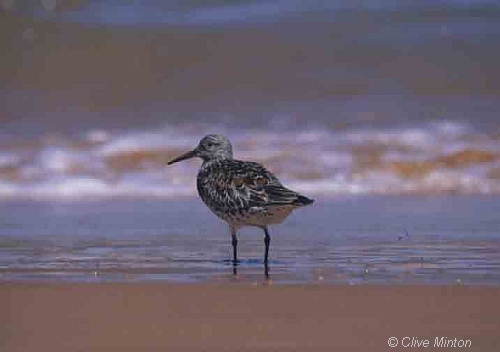Great Knot
Great KnotCalidris tenuirostria | |
|---|---|
| Kingdom: | Animalia |
| Phylum: | Chordata |
| Class: | Aves |
| Order: | Ciconiiformes |
| Sub Order: | Charadrii (waders) |
| Family: | Scolopacidae |
| Status | |
| World: | Vulnerable (IUCN Red List) |
| Australia: | Critically endangered (EPBC Act 1999) |
| Victoria: | Critically Endangered (FFG Threatened List 2023) |
| FFG: | Listed; no Action Statement |
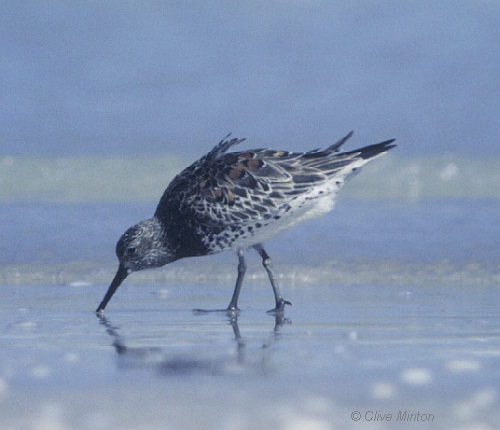
The Great Knot is an international migratory wading bird that travels vast distances between the northern hemisphere breeding grounds and southern hemisphere summer feeding grounds around the coastal fringe of Australia (including Victoria) where it frequents coastal wetlands and sand flats.
The Great Knot is medium sized (28 cm) member of the family Scolopacidae which also includes other waders such as Sandpipers, Snipe, Curlews, Godwits, Tattlers, Stints, Greenshank and Redshank. It has a greyish appearance, dark above, light underneath with chestnut above in breeding plumage. Distinguishing features include; the head and neck are heavily streaked and the sides scalloped grey and white. The head has a white eye brow stripe. The bill is up to 5 cm, slightly down curved. Legs are dark grey to olive green. It has a narrow white wing-bar, and observable white patch on the rump and upper tail-coverts (Higgins & Davies, 1996). The individual is usually silent but calls have been described as a double-noted soft whistle, nyut-nyut (Schodde & Tidemann, 1986).
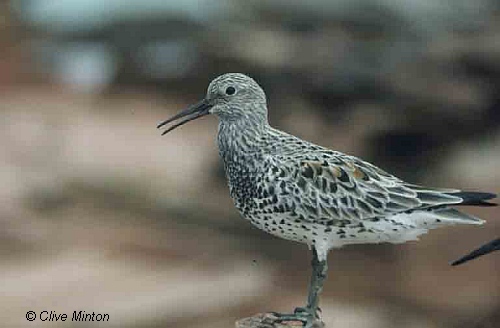
Distribution
Large flocks containing thousands of birds occur in areas of northern Western Australia and smaller flocks sometimes in the hundreds occur in Victoria. Australia is thought to hold most of the worlds population during the non-breeding season (Lane 1987). Outside Australia, important sites are the main breeding area in Russia (north-eastern Siberia), Korea and China (Higgins & Davies 1996; Wilson & Barter 1998). Vitally important migratory staging areas occur in the Yellow Sea around South Korea and China.
In Victoria, studies have shown that there are two sites where flocks occur regularly. These are the intertidal mudflats at Queenscliff and Mud Island, Port Phillip Bay (Emison et al. 1987; Lane & Davies, 1987; Higgins & Davies, 1996). Other sites include the Bellarine Peninsula, Mallacoota, Gippsland Lakes, Corner Inlet, Westernport Bay and Port Fairy. They are very rarely found inland however they have been sited at Woorinen and Mildura (Emison et al. 1987; Higgins & Davies 1996).
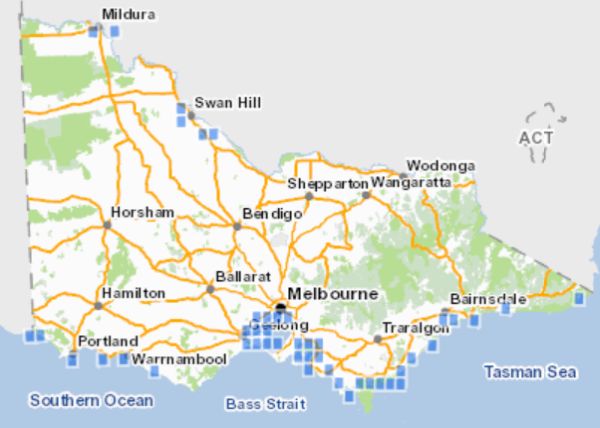
.
Ecology & Habitat
In non breeding areas the Great Knot is mostly found in coastal habitats which comprise large areas of bare or sparsely vegetated intertidal mudflats or sandflats. They are rarely found on inland wetlands and do not favour sandy beaches (Morcombe 2003; Antonov & Huettmann 2004).
Diet
The diet of the Great Knot is mainly bivalve molluscs, gastropods, invertebrates, polychaete worms, crabs, shrimps and sea-cucumbers, they have also been found to eat seeds and berries (Higgins & Davies, 1996; Tomkovich, 1996).
Migration
Great Knots are long distance migrants which use a limited number of staging sites on its annual round trip between breeding grounds of Russia and non-breeding areas in Australia (Wilson 2000). Wilson & Barter (1998) suggest that the Great Knot adopts a ‘long jump’ strategy where they fly non-stop from Australia through to China’s Yellow Sea Region.
Until recently it was estimated 110,000 Great Knots on average migrate from Australia through east China to the breeding grounds in Siberia, Russia (Barter et al. 1997c; Battley et al. 2000) but this number has reduced since 2000. The migration route used by these birds is known as the East Asian-Australasian Flyway. See: East Asian-Australasian Flyway partnership.
Great Knots begin to arrive in Victoria October – November from their northern hemisphere journey.
Great Knots begin to depart Victoria in March – April for their migration to the northern hemisphere.
Migratory routes are usually along coasts with passages through China and Japan and more uncommon passages can occur through Korea, Philippines, Vietnam, Thailand, Malaysia and Indonesia (Higgins & Davies, 1996). Major resting grounds are in the Yellow Sea between China and South Korea.
Breeding
Tomkovich (1995 & 1996) observed from winter breeding grounds in the alpine and subalpine tundra of Siberia, Russia, that the Great Knots start to breed around the age of two years. Pairs take 6-7 days to begin egg laying, and 4-5 days to lay four eggs. The incubation period was between 22-23 days. Fledging occurred from 20 to 25 days.
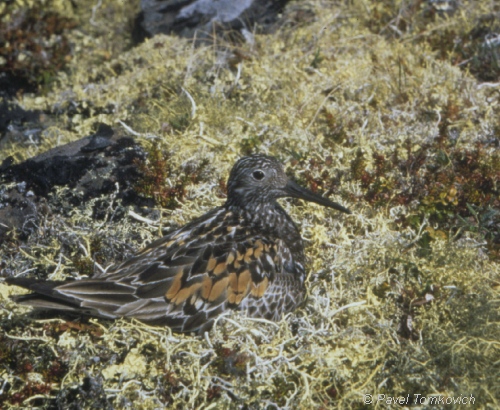
Image courtesy of Pavel Tomkovich
Threats
In 2004 the IUCN estimated that the global population for the Great Knot was about 380,000-390,000 individuals. In 2015 the global population has been revised downwards and is now estimated to be around 290,000 individuals. The IUCN estimates the population has declined approximately 25% since 2000 (Birdlife International 2012).
Lane & Davies (1987) suggested that no more than 2000 Great Knots regularly reach South Australia and Victoria. In the same year, Emison et al. (1987), suggested a maximum of 1500 birds in Victoria. The Victorian Wader Study Group flagging program has flagged 396 Great Knots in Victoria between 1975 and and 2014 (VWSG 2015). In 2001 only 167 birds were estimated to be visiting the state, a dramatic decline over the last decade (SAC 2002).
Great Knot species count in Australia, 1997-2001 (Source: AWC, 2004).
- 1997 = 4,296
- 1998 = 23,122
- 1999 = 18,668
- 2000 = 13,796
- 2001 = 5,344
The conservation status of Great Knot was raised from Vulnerable to Critically endangered in May 2016 under schedules to the EBPC Act 1999.
Major threats
1. Habitat loss and degradation
The Great Knot is reliant on adequate habitat to complete the three main phases in its life cycle;
- breeding grounds in the Northern Hemisphere,
- non breeding feeding areas in Australia and
- migratory stop over areas in between.
With large numbers of birds using relatively few sites changes in habitat can have profound impacts on the overall population. For example, the Great Knot is reliant on a small number of sites during migration which makes it particularly vulnerable to degradation or loss of those sites such as the major concentrations at Chongming Dao, which are heavily disturbed by eel fishing, crab digging, shell fishing, buffalo grazing and reed cutting (Barter et al.1997b).
The loss of important feeding and resting habitat at major migratory stop over areas which once contained mudflats in Saemangeum Estuary in South Korea has significantly impacted on the overall population.
Disturbance to non-breeding populations in Australia could impact on feeding and resting and may be caused through inappropriate boating, hovercraft, off road vehicles, dogs and human interference.
2. Hunting
Hunting in overseas countries has been identified as a major threat to the Great Knot (SAC 2002). As a numerous species in Asia, it is sometimes attractive to hunters. Researchers recovered several birds with Australian bands as a result of hunting (Tomkovich, 1997). Barter et al. (1997a) commented that predictions made in 1992 that the harvest for Great Knots would decline due to falling hunter numbers, increased income and habitat reclamation, have not occurred.
3. Pollution
Contamination of inter-tidal areas can occur from oil spills and polluted discharge from stormwater run off.
4. Unfavourable Land Management
Problems for shorebirds in Australia have dramatically increased in the past 200 years because of changes in land management. The increasing demand for land and pressure for other forms of land use continues to impact negatively on shorebirds and habitat (Watkins, 1993). The proximity of coastal developments to known intertidal habitat of the Great Knot may increase chances of disturbance and degradation of habitat.
Invasion of Spartina which is an exotic perennial grasses capable of invading intertidal mudflat, salt marsh, mangrove and sea grass habitats poses a direct threat to wading bird habitat in areas where it exists (Lane 1992). Monitoring and control of Spartina is necessary to protect intertidal mudflats.
Loss of intertidal mudflats in overseas staging / resting /feeding areas. For example, threats beyond Australia which have impacted on the Great Knot is the closure of the Saemangeum Estuary in South Korea. This project has damaged 40,000ha of tidal flats behind a 33km long sea wall. Saemangeum is regarded as one of the most important sites for many shorebirds in the Yellow Sea and this is thought to have massive impacts on the environment. It is believed that the reclamation of Saemangeum has drastically reduced the habitat available to migratory shorebirds including the Great Knot.
Conservation & Management
The Australian Government is managing migratory waders by participating in international agreements such as:
- Ramsar Convention
- Bonn Convention
- Japan Australia Migratory Bird Agreement (JAMBA 1981)
- China Australia Migratory Bird Agreement (CAMBA 1988)
The Government is cooperating with other countries throughout the Asia-Pacific region to conserve waterbirds and their habitat under the Asia Pacific Migratory Waterbird Conservation Strategy
Wildlife Conservation Plan for Migratory Shorebirds 2015
Conservation measures relevant to Victoria
The conservation status of Great Knot was re-assessed from Endangered in 2013 (DEPI 2013) to Critically Endangered in 2020 as part of the Conservation Status Assessment Project – Victoria (DELWP 2020).
- Monitor populations through counting and banding in order to collect data on changes on a local, national and international basis.
- Monitor migrations through counting and banding in order to collect data on changes on a local, national and international basis.
- Determine census data and regular site monitoring as suggested by Thompson (1993),
- Protection and maintenance of known or potential habitat, possibly through the implementation of protection zones.
- Review local and regional planning schemes,
- Develop policies and strategic frameworks for the Great Knot and areas of importance in order to manage populations and important habitat,
- Encourage other scientific studies of the Great Knot: i.e. movement of Great Knot in Victoria and gather information on amounts of disturbance on important sites.
- Encourage and promote involvement of volunteers and professionals to assist in achieving these objectives.
References & Links
- Antonov, A. & Huettmann, F. (2004) On the southward migration of Great Knot in the western Sea of Okhotsk: results and conclusions from co-ordinated surveys of Northern Sakhalin Island and Schastia Bay, 2002. Stilt 45: 13-19 .
- AWC Report. (2004) Wetlands International Oceania.
- Barter, M. (1986) Great Knot partly undone. The Stilt 12: 29-32.
- Barter, M., Fawen, Q., Sixian, T., Xiao, Y. & Tonkinson, D. (1997a) Hunting of migratory waders on Chongming Dao: a declining occupation? The Stilt 31: 18-22.
- Barter, M., Tonkinson, D., Sixian, T., Xiao, Y. & Fawen, Q. (1997b) Wader numbers on Chongming Dao, Yangtze Esturary, Ching, During early 1996 northward migration and the conservation implications. The Stilt 30: 7-13.
- Barter, M., Tonkinson, D., Sixian, T., Xiao, Y. & Fawen, Q. (1997c) Staging of the Great Knot Calidris tenuirostris, Red Knot C. canutus and Bar-tailed godwit Limosa lapponica at Chongming Dao, Shanghai: Jumpers to hoppers? The Stilt 31: 2-11.
- Battley, P. F., Piersma, T., Dietz, M. W., Tang, S., Dekinga, A. & Hulsman, K. (2000) Empirical evidence for differential organ reductions during trans-oceanic bird flight. Proceedings of the Royal Society of London. Series B, Biological sciences 267: 191-195.
- BirdLife International. 2012. Calidris tenuirostris. The IUCN Red List of Threatened Species 2017: Accessed 29 March 2017.
- *CAMBA. (1988) Agreement between the Government of Australia and the Government of the People’s Republic of China for the Protection of Migratory Birds and their Environment. CAMBA 1988, Department of Foreign Affairs and Trade, Canberra.
- *Emison, W. B., Beardsell, C. M., Norman, F. I., Loyn, R. H. & Bennett, S. C. (1987) Atlas of Victorian Birds. P: 116. Department of Conservation, Forests & Lands and the Royal Australasian Ornithologists Union, Melbourne.
- FFG Threatened List (2023) Flora and Fauna Guarantee Act 1988 - Threatened List - June 2023, Department of Energy, Environment and Climate Action (DEECA) , Victoria.
- *Higgins, P. J. & Davies, J. N. (1996) [eds] Handbook of Australian, New Zealand and Antarctic Birds. Volume 3. Pp: 214-224. Royal Australasian Ornithologists Union. Oxford University Press, Melbourne.
- JAMBA. (1981) Agreement between the Government of Australia and the Government of Japan for the Protection of Migratory Birds in Danger of Extinction and their Environment. JAMBA1981. Department of Foreign Affairs and Trade, Canberra.
- Lane, B. (1992) Impact of Spartina on international migratory waders. In: The sea has weeds too! Proceedings of a Conference on the Problem of Spartina, Inverloch, 1991, Ed. Frazer-Quick, G., Phillips, A., Published by Department of Conservation & Environment, May 1992.
- Lane, B. A. & Davies, J. N. (1987) Shorebirds in Australia. Pp: 121-124. Royal Australasian Ornithologists Union. Nelson Publishers, Melbourne.
- Marchant, J. H. (1986) Identification, habits and status of Great Knot. British Birds 79: 123-135.
- Morcombe, M. (2003) Field Guide to Australian Birds. Steve Parish Publishing, Queensland.
- SAC (2002) Final Recommendation on a nomination for listing: Great Knot Calidris tenuirostris (Nomination No. 562). Scientific Advisory Committee, Flora and Fauna Guarantee. Department of Sustainability and Environment: Melbourne.
- Schodde, R. & Tidemann, S. C. (1986) [eds] Readers Digest Complete Book of Australian Birds. Readers Digest Services Pty Ltd, Sydney.
- Tomkovich, P. S. (1995) Great Knot on Siberian breeding grounds. Dutch Birding 17: 15-21.
- Tomkovitch, P. S. (1996) A third report on the biology of the Great Knot Calidris tenuirostris, on the breeding grounds. Stilt 28: 43-45.
- Tomkovich, P. S. (1997) Breeding distribution, migrations and conservation status of the Great Knot Calidris tenuirostris in Russia. Emu 97: 265-282.
- VBA (2019) Victorian Biodiversity Atlas, Department of Environment, Land, Water & Planning, Victoria. Sourced: 15 January 2019.
- VWSG (2015) Victorian Wader Study Group Bulletin No. 38, April 2015.
- Watkins, D. (1993) A National Plan for Shorebird Conservation in Australia. Australian Wader Studies Group, Royal Australasian Ornithologists Union. RAOU Report No. 90.
- Wilson, J. (2000) Australasian wader studies group conference, Griffith University, Brisbane, Australia 1-2 July 2000. The Stilt 37: 49-53.
- Wilson, J. R. & Barter, M. A. (1998) Identification of potentially important staging areas for ‘long jump’ migrant waders in the east asian-australasian flyway during northward migration. The Stilt 32: 16-28.
More Information
